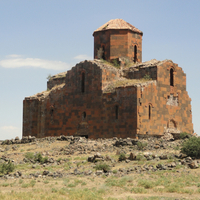The Church at Mren: Historical accounts and inscriptions
Introduction:
The imposing church at Mren is hardly recorded at all in Armenian sources, but inscriptions on the building itself help date the structure based on the names recorded. The surviving (b) carved and (c) painted inscriptions are translated here, preceded by (a) a brief passage in a tenth-century historical text that helps make sense of those inscriptions.
Translations: Some passages have been simplified and words added in brackets to aid comprehension.
(a) Mention of Mren in History of the Armenians by Yovhannēs Drasxanakerc‘i (John the Catholicos), tenth century:
Translations: Some passages have been simplified and words added in brackets to aid comprehension.
(a) Mention of Mren in History of the Armenians by Yovhannēs Drasxanakerc‘i (John the Catholicos), tenth century:
In the same period, Emperor Herakleios designated Dawit‘ Saharuni as curopalates [palace guardian] and installed him as prince of Armenia, where he ruled wisely for three years with distinction and great success. The splendid church in the town of Mren was built at his behest.(b) Fragmentary Armenian inscription carved high on the west facade, ca. 640:
In the . . . year of Herakleios, the happily victorious king, the office of prince [i.e., Dawit‘ Saharuni] . . . all-praiseworthy patrik, curopalates, and general [of Armenia] and Assyria and the episcopate of [T‘e]ovpiłos and the office of tanuter [head of household] Nerseh [lord of . . .] and Ašarunik‘ this holy church was built [for the intercession of] the Kamsarakan and Mren and all [the lands of Armenia].(c) Armenian inscription painted around the central apse, ca. 640:
Holiness befits your house, Lord, for the length of days.


